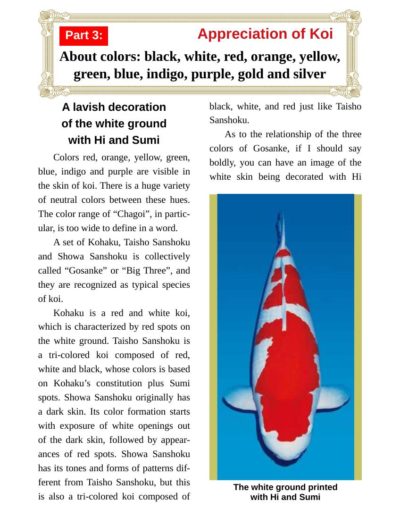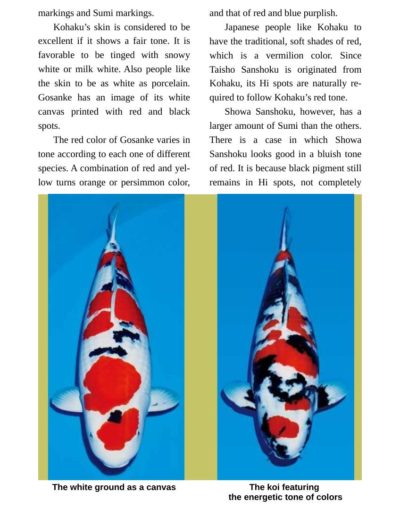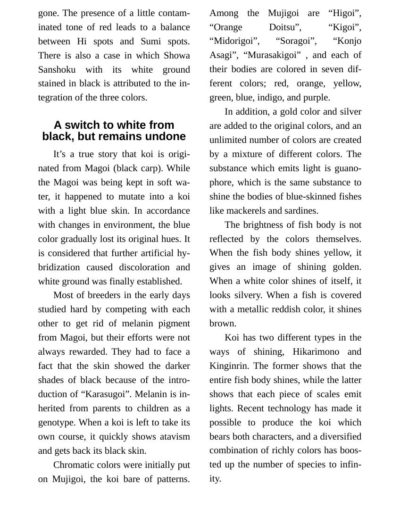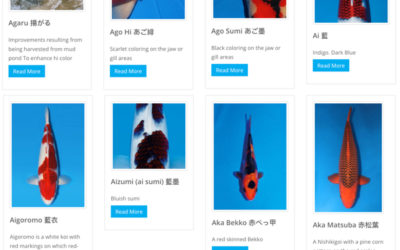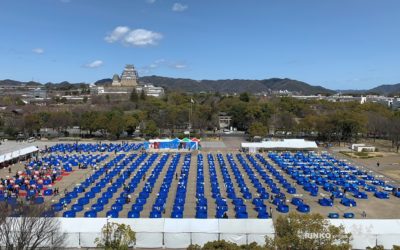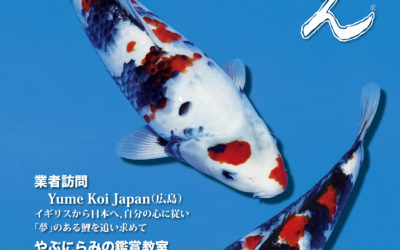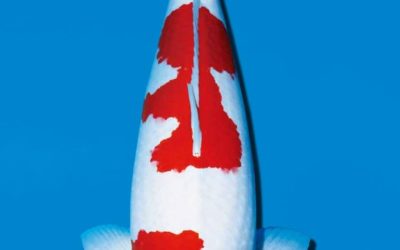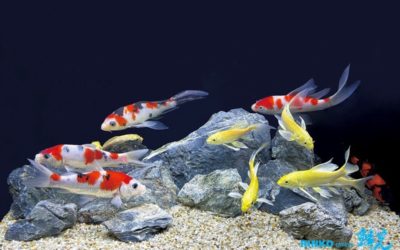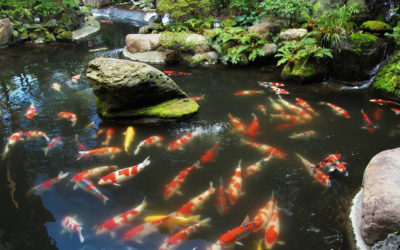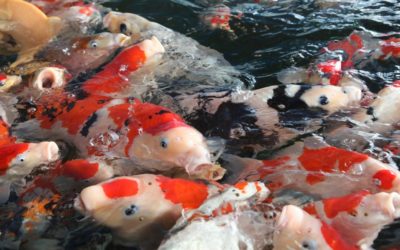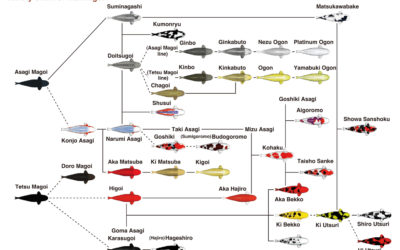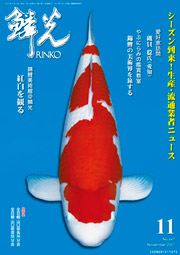Appreciation of Koi Part 3:
About colors: black, white, red, orange, yellow, green, blue, indigo, purple, gold and silver
A lavish decoration of the white ground with Hi and Sumi
Colors red, orange, yellow, green, blue, indigo and purple are visible in the skin of koi. There is a huge variety of neutral colors between these hues. The color range of “Chagoi”, in particular, is too wide to define in a word.
A set of Kohaku, Taisho Sanshoku and Showa Sanshoku is collectively called “Gosanke” or “Big Three”, and they are recognized as typical species of koi.
Kohaku is a red and white koi, which is characterized by red spots on the white ground. Taisho Sanshoku is a tricolored koi composed of red, white and black, whose colors is based on Kohaku’s constitution plus Sumi spots. Showa Sanshoku originally has a dark skin. Its color formation starts with exposure of white openings out of the dark skin, followed by appearances of red spots. Showa Sanshoku has its tones and forms of patterns different from Taisho Sanshoku, but this is also a tricolored koi composed of black, white, and red just like Taisho Sanshoku.
As to the relationship of the three colors of Gosanke, if I should say boldly, you can have an image of the white skin being decorated with Hi markings and Sumi markings.
Kohaku’s skin is considered to be excellent if it shows a fair tone. It is favorable to be tinged with snowy white or milk white. Also people like the skin to be as white as porcelain. Gosanke has an image of its white canvas printed with red and black spots.
The red color of Gosanke varies in tone according to each one of different species. A combination of red and yellow turns orange or persimmon color, and that of red and blue purplish.
Japanese people like Kohaku to have the traditional, soft shades of red, which is a vermilion color. Since Taisho Sanshoku is originated from Kohaku, its Hi spots are naturally required to follow Kohaku’s red tone.
Showa Sanshoku, however, has a larger amount of Sumi than the others. There is a case in which Showa Sanshoku looks good in a bluish tone of red. It is because black pigment still remains in Hi spots, not completely gone. The presence of a little contaminated tone of red leads to a balance between Hi spots and Sumi spots. There is also a case in which Showa Sanshoku with its white ground stained in black is attributed to the integration of the three colors.
A switch to white from black, but remains undone
It’s a true story that koi is originated from Magoi (black carp). While the Magoi was being kept in soft water, it happened to mutate into a koi with a light blue skin. In accordance with changes in environment, the blue color gradually lost its original hues. It is considered that further artificial hybridization caused discoloration and white ground was finally established.
Most of breeders in the early days studied hard by competing with each other to get rid of melanin pigment from Magoi, but their efforts were not always rewarded. They had to face a fact that the skin showed the darker shades of black because of the introduction of “Karasugoi”. Melanin is inherited from parents to children as a genotype. When a koi is left to take its own course, it quickly shows atavism and gets back its black skin.
Chromatic colors were initially put on Mujigoi, the koi bare of patterns. Among the Mujigoi are “Higoi”, “Orange Doitsu”, “Kigoi”, “Midorigoi”, “Soragoi”, “Konjo Asagi”, “Murasakigoi” , and each of their bodies are colored in seven different colors; red, orange, yellow, green, blue, indigo, and purple.
In addition, a gold color and silver are added to the original colors, and an unlimited number of colors are created by a mixture of different colors. The substance which emits light is guanophore, which is the same substance to shine the bodies of blueskinned fishes like mackerels and sardines.
The brightness of fish body is not reflected by the colors themselves. When the fish body shines yellow, it gives an image of shining golden. When a white color shines of itself, it looks silvery. When a fish is covered with a metallic reddish color, it shines brown.
Koi has two different types in the ways of shining, Hikarimono and Kinginrin. The former shows that the entire fish body shines, while the latter shows that each piece of scales emit lights. Recent technology has made it possible to produce the koi which bears both characters, and a diversified combination of richly colors has boosted up the number of species to infinity.
Enjoy our collection of articles on Japanese koi news, updates, winners, educational articles, definitions and more!
Join as a free RINKO Member for increased access and subscribe as a paid member for full access to our content.
The 9th International Junior Koi Show
by RINKO Online | May 11, 2022
The 9th International Junior Koi Show was held at Ojiya Gymnasium on 23-24th...
Learning Japanese Koi Words
by RINKO Online | Apr 26, 2022
Koi? Goi? Koromo? Goromo? We have seen many people are confused about...
The 38th All Japan Young Koi Show
by RINKO Online | Apr 21, 2022
The 38th All Japan Young Koi Show was held at Otemae-Park in front of Himeji...
Japanese RINKO May issue adverts
by RINKO Online | Apr 20, 2022
Japanese RINKO 2022 May issue adverts
Rinko Magazine Releases Issue 18 April 2022
by RINKO Online | Apr 18, 2022
April 2022 issue (No. 796) Table of Contents Pet-centered policy grows koi...
Hirenaga Nishikigoi with Tokatsu Pet Shop Nagareyama
by RINKO Online | Feb 4, 2022
Tokiwabashi
by RINKO Online | Feb 3, 2022
Tokiwabashi Project The Tokiwabashi Project in front of Tokyo Station...
Koi Breeding is Kaneko’s Speciality
by RINKO Online | Feb 3, 2022
A Story Of Taro’s Adventure
by RINKO Online | Feb 3, 2022
Introduction of Koi Fish (4) Koi Keeping
by RINKO Online | Jan 26, 2022
The Point of Koi Keeping The most important point of koi keeping is to create...
Introduction of Koi Fish (3) General Information
by RINKO Online | Jan 26, 2022
The Year of the Koi-Breeding District The koi harvest is in the middle of...
Introduction of Koi Fish (2) Varieties
by RINKO Online | Jan 26, 2022
Japanese Koi VarietiesHistory | Varieties | General...
RINKO Koi Magazine is NOW available online!
Blog Categories
Reminder: You must login or register for website to vote in our polls.
Recent Posts
Upcoming Events
Author: RINKO Online
RINKO was published in 1962 as the first Nishikigoi magazine in the world. Dr Takeo Kuroki organized Oita Airinkai (koi club) with 53 members. He wrote the most articles which were written on A5 size paper, printed in black and white and 28 pages long with his wife’s artwork on the front cover. When Dr Kuroki met our founder Shuji Fujita, they consulted on publishing his first book “Nishikigoi”. This created hundreds and thousands of “koi-kichi” (koi lovers/people crazy about koi). Their work together resulted in the success of RINKO Issue 15, the first cover printed in color. Since then their journey of introducing Nishikigoi culture to the world has blossomed.

